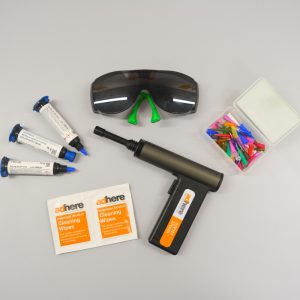 The IUV101 Medical Kit contains everything a manufacturer needs to start working with UV curing adhesive technology for medical device bonding, including three widely used adhesives in 10 ml syringes, alongside the IUV101 LED UV Spot Lamp for Handheld UV Light Curing. This device has a powerful 2,000 mW/cm2 light intensity, which users can focus on the exact spot where cure is required. The kit also contains wipes, dispensing needles, PPE, and some helpful guides to best practice when using a process. With everything needed to get going included, the kit is an inexpensive way for manufacturers that have not yet tried UV light curing adhesives to get started.
The IUV101 Medical Kit contains everything a manufacturer needs to start working with UV curing adhesive technology for medical device bonding, including three widely used adhesives in 10 ml syringes, alongside the IUV101 LED UV Spot Lamp for Handheld UV Light Curing. This device has a powerful 2,000 mW/cm2 light intensity, which users can focus on the exact spot where cure is required. The kit also contains wipes, dispensing needles, PPE, and some helpful guides to best practice when using a process. With everything needed to get going included, the kit is an inexpensive way for manufacturers that have not yet tried UV light curing adhesives to get started.
- The first material, Dymax 215-CTH-SV01-UR-SC is commonly used for plastic bonding, such as in catheter assembly. It includes Encompass™ technology, meaning the material is red fluorescing, and also turns from blue to colourless upon cure, which helps make inspection processes easier. The material bonds well to medical plastics, including: ABS, PA, PC, PCTG, PEBA, PEI, PET, PETG, PI, PMMA, PS, PSU, PU, PVC, SAN, TPU, and AL.
- The second material, Dymax 1405-M-T-UR-SC, is suitable for metal to glass bonding, as well as metal to plastic assembly, and is commonly used in needle bonding. Also formulated with Encompass technology, the material can be cured at both long wave UV and 405 nm visible light. It bonds to a range of medical plastics, including ABS, PC, PCTG, PEI, PETG, PMMA, PS, PSU, PU, PVC, SAN, TPU, and SS.
- The third material, Dymax 1181-M is frequently used as a medical device adhesive and coating, such as during the assembly of medical electronics. The material bonds to PC, CAP, PVC, PS, PETG, and ABS.
UV curable adhesives are growing in use due to their process and productivity benefits. Materials cure in seconds “on demand” on exposure to the correct wavelength of UV light, speeding up the process compared with other adhesive chemistries. In addition, UV curing adhesives require no special application equipment, are single part, and available in a range of viscosities. They also lend themselves well to an automated process, as dispensing and cure is readily controlled and repeatable.
However, if you’re manufacturing medical devices, you first need to establish that the process will be reliable, repeatable, and validatable before reaping the benefits of this adhesive technology. To help, we specially selected the three adhesives for the kit to be suitable candidates for ~80% of potential applications. Using these test materials, you can do your process development and establish whether a UV curing material might work your application.
Categories: LED Curing, medical, uv curing
